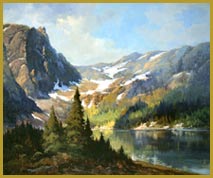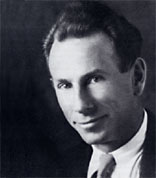| Robert Wood in the Catskills
by Jeffrey Morseburg
When Robert Wood was at the peak of his popularity and fame, the subject he was most associated with was eastern American landscape. Works like "Autumn Bronze," "October Gold" and "October Morn" became incredibly popular reproductions that remain sentimental favorites for thousands of Americans and Canadians who either live in the East or who wish to remember growing up there.
Robert W. Wood was painting in the Catskills by the early 1930s, and his works of that period emphasized the grandeur of the tall trees of the area, usually depicted in their autumn colors. Most of these works were painted in and around the historic artists' colony of Woodstock, New York, deep in the picturesque Catskill Mountains of upstate New York.
In the years after WWII, he purchased a cabin in Woodstock where he could go to capture the fall colors. Between his second and third marriages, to Tula Wood and Caryl Wood, he was involved with a woman named Rose – whom he may or may not have married – and for a period of about two years they lived in Woodstock together with her mother. This was about 1952-1954. The relationship foundered (because of Rose's instability, according to some accounts) and Wood moved back to Laguna Beach, CA, where Rose later followed him, trading on his name well into the 1970s
It was during this period – the 1950s – that the Donald Art Company, run by Donald Bonnist, Sr., published many of Robert Wood's eastern scenes. Wood developed a close working relationship with Bonnist, whose company was located in Port Chester, New York, and they became his exclusive publisher. The Donald Art Co. published the work of hundreds of historic and contemporary artists and produced a large annual color catalog of their reproductions. Wood became their best-selling painter and eventually they reproduced over one hundred of his paintings.
In addition to his fall scenes, Wood painted winter, spring and summer landscapes in and around Woodstock. From there he also traveled to Vermont, New Hampshire and the Maine coast. His best-known works, though, were of the rustic landscape around his cabin, which was surrounded by maple and elm trees and a brook. This is where "October Morn" and "Four Seasons" were painted. Long after he left Woodstock, Wood painted Eastern scenes from sketches and they remained a significiant part of his artistic ouevre until the end of his long life.
Copyright
2003 Jeffrey Morseburg. Not to be reproduced without specific written
permission. |



